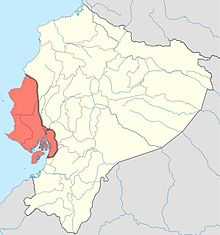Manteño civilization

The Manteño civilization (Spanish: Los Manteños) were the last pre-Columbian civilization in modern-day Ecuador, active 1150-400 b.p. (850–1600 CE).[1] It encompases the area of the earlier Valdivia Culture
Scope
The term was coined by Ecuadorian archeologist Jacinto Jijón y Caamaño, to describe pre-Hispanic settlement near the town of Manta and engulfed in part by the more recent settlement.[2] It was soon after this that the term Manteño was greatly widened in scope to include several distinct sub-groups: northern Manteño (Manteño del Norte, Sillas, or Manabita), southern Manteño (Huancanvelica) and Punáe. Some archaeologists and historians reject this split, however, and apply the term Huancanvelica – a term of Incan origin, from the time of the first colonisation – to all three groups. Little work has distinguished such groupings.[3] One historian, however, Cieza de León, has claimed that residents in coastal towns north of Salango used a type of facial tattoo distinguishable from those to their south. Other proposed divisions have included coastal and inland areas, based on types of burial and subsistence.[2]
The Manteño chiefdoms – under the broad definition – extended over coastal parts of the Manabi and Guayas provinces, including La Plata Island. The Bahía de Caráquez and Chone River mark its northern boundary, and the Guayas basin its southern boundary.[1]
The town of Picoazá was the site of a Manteño chiefdom, according to early colonial sources.[4] In addition, major sites have been found at the Cerro de Hojas and Cerro Jaboncillo, the Cerro de Paco, Cerro las Negras, Cerro los Santo, Bellavista, Agua Blanca, Loma de los Cangrejitos, López Viejo, Los Frailes, Montecristi, Olón, Salango and La Libertad.[1]
Organisation
Many (if not all) were split into four major settlements, with the chief of the principal settlement overlord.[4] Caamaño believed that the Manteños operated like a trading ring rather than a kingdom or empire, and drew parallels to the Hanseatic League.[5] Manteño settlements typically contain large quantities of characteristic pottery and large stone foundations.[6]
References
- ↑ 1.0 1.1 1.2 Peregrine (2001) p.303
- ↑ 2.0 2.1 Silverman, H., Isbell, W. (2008). Handbook of South American Archaeology. p. 505–14. Retrieved 28 March 2010.
- ↑ Peregrine (2001) p.313
- ↑ 4.0 4.1 Peregrine, P. N. et al. (2001). Encyclopedia of Prehistory: Middle America 5. p. 307. Retrieved 28 March 2010.
- ↑ Silverman (2008) p.512
- ↑ Peregrine (2001) p.320